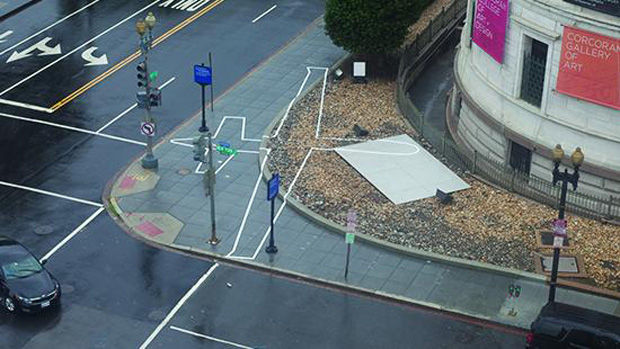Museum examines ‘Contemporary Art and Drone Warfare’
Published February 29, 2016
How do we use the technology we’ve created? How should we use the technology we’ve created? Where does the boundary lie between freedom and security? In the early twenty-first century, these questions center on drone warfare, surveillance, safety and civil liberties.
The exhibition “To See without Being Seen: Contemporary Art and Drone Warfare” at the Mildred Lane Kemper Art Museum on the campus of Washington University tackles and attempts to answer these questions. Through video sculptures, photographs, installation art, and web-based projects, artists in the exhibition explore power, fear, agency, technology, and visibility. Much of the work “looks at the US the way the US looks at other countries—through a drone’s perspective.”
Trevor Paglen, one of the most provocative artists in the show, photographs and investigates “places that officially ‘do not exist’, such as military black sites.”
One photograph, titled “National Reconnaissance Office Ground Station (ADF-SW) Jornada del Muerto, NM; Distance 16 Miles,” which is part of the artist’s series Limit Telephotography, reveals a domed building atop a hill in New Mexico. Paglen used strong astronomical telescopes to bring this site into view. It’s so remote that it cannot be seen with the naked eye. The image is blurry because of distortion due to the lenses and filters Paglen used. He believes “photography is as much about the right to capture images of sites hidden from public scrutiny as about the image itself.”
Another of his photographs, visually beautiful despite its disturbing subject matter, is titled “KEYHOLE IMPROVED CRYSTAL from Glacier Point (Optical Reconnaissance Satellite; USA 224.” This is part of Paglen’s series “The Other Night Sky” in which he “tracks and photographs classified American satellites orbiting Earth.” The image shows a western mountainous landscape at dusk or dawn. Paglen used a long exposure to capture the movements of dozens and dozens of what appear to be stars but are actually the lights of military satellites.
In addition to more serious subject matter, To See Without Being Seen also includes some surprising, almost comical takes on the presented themes.
Adam Harvey, an artist and fashion designer, displays six photographs from his CV Dazzle series. Harvey “uses high fashion to camouflage citizens from modern surveillance.” Each photograph depicts a male or female model for whom Harvey created a contemporary hairstyle that covers part of the face and “blocks detection by facial-recognition algorithms.” Human viewers have the ability to recognize the models’ faces as human, while computers are confused.
Another interesting commentary on computerized surveillance is found in the piece Cloud Face, created by the collective Shinseungback Kimyonghun, formed by the South Korean artists Shin Seung Back and Kim Yong Hun. Cloud Face is comprised of 32 photographs of “faces” found in clouds by facial-recognition software. This piece demonstrates an imperfection of such technology, which finds faces where none exist.
“To See without Being Seen: Contemporary Art and Drone Warfare” is on view at the Mildred Lane Kemper Art Museum through April 24. The museum is located at 1 Brookings Drive between Brookings Hall and Skinker Boulevard. Museum hours are 11 a.m. to 5 p.m. Wednesday through Monday and closed on Tuesday. On the first Friday of each month, the museum is open until 8 p.m. For more information, call 314-935-4523 or visit www.kemperartmuseum.wustl.edu.
















